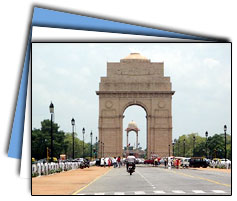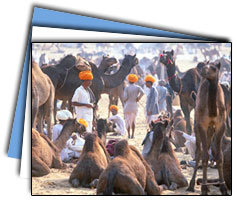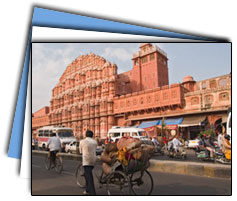
Ajmer situated in the green oasis wrapped in the barren hills has been a witness to an interesting past. The city was founded by Raja Ajai Pal Chauhan in the 7th century A.D. and continued to be a major centre of Chauhan power. When Prithviraj Chauhan lost it to Mohammed Ghauri leaving behind indelible marks of their culture and traditions on the cities history, converting it to an amalgam of various cultures and a blend of Hinduism and Islam.
South west of Jaipur, Ajmer is an oasis wrapped in the green hills. The city was founded by Raja Ajay Pal Chauhan in the 7th Century A.D. and continued to be a major centre of the Chauhan power till 1193 A.D. When Prithviraj Chauhan lost it to Mohammed Ghauri. Since then, Ajmer became home to many dynasties.
Today, Ajmer is a popular pilgrimage centre for the Hindus as well as Muslims. Especially famous is the Dargah Sharif-tomb of the Sufi saint Khwaja Moinuddin Chisti, which is equally revered by the Hindus and Muslims. It is a centre of culture and education, the British chose Ajmer for its prestigious Mayo College a school exclusively for Indian nobility.
Ajmer is also the base for visiting Pushkar (11 km.), the abode of Lord Brahma, lying to its west with a temple and a picturesque lake. The Pushkar Lake is a sacred spot for Hindus. During the month of Kartik (Oct./Nov.), devotes throng in large numbers here to take a dip in the sacred lake.

Ajaipal Chauhan founded Ajmer in the seventh century. He constructed a hill fort "Ajaimeur" or the invincible hill. The Chauhans ruled Ajmer till the 12th century when Prithviraj Chauhan lost Mohammed Ghauri. Thereafter it became a part of the sultanate of Delhi. Ajmer was also favourite residence for the great Mughals.
One of the first contacts between the Mughal King Jahangir and Sir Thomas Roe took place here in 1616. The Scindias took over the city in 1818 and then handed it over to the British and it became one of the only part of Rajasthan controlled directly by the East Indian Co.
The bus stand in Ajmer is located near the RTDC hotel Khadim. And the railway is further north and most of the hotels are west of the stations. Northeast is the main post office and most of the cities market is located behind and up to Agra Gate. Further north is a large artificial lake called the Anna Sagar.
Places to See :  Durgah in Ajmer ( Khwaja Sahib )
Durgah in Ajmer ( Khwaja Sahib ) It is the landmark of Ajmer and one of the holiest of Muslim shrines in the country. It has a secular appeal and revered by people of all sect. Khwaja Moin-ud-din Chisti, a Sufi saint from Persia made this place his abode from 1192 till he died in 1236 AD. Mughal King Humayun completed the construction of the shrine. The Dargah is approached through a massive gate with silver doors built in several stages. Emperor Akbar made an annual pilgrimage to Ajmer.
Lakes in Ajmer : Ana Sagar It is an artificial lake named after Anaji Chauhan. The catchments were built with the help of local populace. The 'Baradari' pavilions was built by Shah Jahan, to facilitate his long stays in Ajmer. the Baradari and the adjoining parks are the lungs of city and favourite outing spot.
 Dargah Khwaja Sahib :
Dargah Khwaja Sahib : It is the landmark of Ajmer and one of the holiest of Muslim shrines in the country. It has a secular appeal and revered by people of all sect. Khwaja Moin-ud-din Chisti, a Sufi saint from Persia made this place his abode from 1192 till he died in 1236 AD. Mughal King Humayun completed the construction of the shrine. The Dargah is approached through a massive gate with silver doors built in several stages. Emperor Akbar made an annual pilgrimage to Ajmer.
Mughal Emperors Akbar and Shah Zahan have built mosques in the complex. The saint's tomb is in the centre of the second courtyard and the actual tomb inside is surrounded by a silver railing and partly by a marble screen. The tomb is of marble and dome is gold plated. The atmosphere inside the shrine is charged and supernatural with burning of incense and offerings of flowers mainly rose and sweets.
As you enter the Dargah courtyard, you see two massive 'degs' meaning cauldrons. Mughal Emperors Akbar and Jahangir donated these cauldrons originally but they have been replaced in the nineteenth century. The larger cauldron can contain as much as 4480 kgs of rice while the smaller one contains 2240 kgs of rice.

The shrine comes alive with activity when millions of devotees throng the shrine during Urs fair. Urs is held on the seventh lunar month according to Islamic calendar and is variable according to the solar calendar. Sufis and believer converge from all over India and abroad, as it is believed that those visiting during Urs receives special blessings of the saint.
It is compulsory that you cover your head while inside the complex so remember to carry a skullcap or a scarf. The skull-cap is on sale in the colourful market just outside the Dargah. It is also customary to make floral offerings mainly of roses, incense sticks and sweets that are locally available.
Fair & Festival in Ajmer : URS FAIR (Twice a Year) 
The lakeside city of Ajmer is located in central Rajasthan, and is held in great reverence by devotees of all communities who call it 'Ajmer Sharif' (Holy Ajmer). It is here that the mortal remains of the highly respected Sufi saint Khwaja Moin-ud-din Chishti lie buried. The Khwaja came from Persia and established the Chishtia order of fakirs in India. He is popularly known as Gharib Nawaz (protector of the poor) because he dedicated his entire life to the service of mankind.
His spartan life spanned almost a hundred years and he embraced death in solitude while he had withdrawn to his cell for six days, asking not to be disturbed. The Dargah Sharif in Ajmer is the place where the Saint's mortal remains lie buried and is the site of the largest Muslim fair in India. More than five lakh devotees belonging to different communities gather from all parts of the subcontinent to pay homage to the Khwaja on his Urs (death anniversary) during the first six days of Rajab (seventh month of the Islamic calendar.)
The pilgrims who come to seek the blessings of the Khwaja make rich offerings called nazrana at the holy spot where the saint has been entombed. The offerings of rose and jasmine flowers, sandalwood paste, perfumes and incense contribute to the fragrance that floats in the air inside the shrine. Also offered by devotees are the chadar, ghilaph and neema, which are votive offerings for the tomb.
These are brought by devotees on their heads and handed over to the khadims inside the sanctum sanctorum. Outside the sanctum sanctorum of the dargah, professional singers called qawwals in groups and sing the praises of the saint in a characteristic high pitched voice. People gather around them and listen attentively, sometimes clapping to the rhythm of their instruments.

The Urs is initiated with the hoisting of a white flag on the dargah by the Sajjada Nashin (successor representative) of Chishtis. It is done on the 25th of Jamadi-ul-Akhir (sixth lunar month), with the accompaniment of music. On the last day of the sixth month, the Jannati-Darwaza (gateway of heaven) is flung open early in the morning. People cross this gate seven times with the belief that they will be assured a place in heaven. On the 1st of Rajab, the tomb is washed with rose water and sandalwood paste and anointed with perfumes. This ritual is called ghusal. The tomb is then covered with an embroidered silk cloth by the Sajjada Nashin.
 URS FAIR (Twice a Year)
URS FAIR (Twice a Year) An interesting ritual is the looting of kheer (milk-pudding) which is cooked in two large cauldrons called degs and distributed to the devotees as tabarruk (blessed food).
On the 6th of Rajab, after the usual mehfil and the sound of cracker-bursts accompanied by music, the Sajjada Nashin performs the ghusal of the tomb. Fatiha and Salamti are read. A poetic recitation called mushaira is arranged in which poets of all communities arrive to recite compositions dedicated to the Khwaja. The Qul (end-all) on the 6th of Rajab marks the end of the Urs.
At night, religious assemblies called mehfils are held in the mehfil-khana, a large hall meant for this purpose. These are presided over by the Sajjada Nashin of the dargah.
Qawwalis are sung and the hall is packed to capacity. There are separate places reserved for women who attend the mehfil. The mehfil terminates late in the night with a mass prayer for the eternal peace of the Khwaja in particular and mankind in general.
The Dargah is located at the conjunction of three bazaars. There are a number of restaurants around the Dargah where visitors can choose from a variety of dishes most of which are non-vegetarian preparations. Guest houses on the road leading to the Dargah offer accommodation that ranges from economical to luxurious. Many other guest houses are strewn across the city.

The shops in the market around the Dargah sell flowers, prayer mats, rosaries, textiles, and general merchandise as well. Ajmer is 132 kms. south-west of Jaipur and 198 kms. east of Jodhpur. It is connected by road to Jaipur, Jodhpur, Bikaner, Udaipur and Kota. Ajmer is a railway junction on the Delhi-Ahmedabad section of the Western Railway. During the Urs, special buses ply from cities all over India carrying people to Ajmer and back.
Excursions of Ajmer : Kishangarh Kishangarh is 27 Kms north east of Ajmer and was founded by Kishan Singh a Rathore Prince. In the 18th century it acclaimed fame as one of the finest schools of miniatures paintings. Though a smaller school with a much shorter duration it had a more refined style. It peaked under the patronage of Savant Singh an heir to the throne, who later became a hermit. It is said that Savant Singh modeled as Krishna while his mistress nicknamed as Bani Thani modelled for Radha. Paintings of Bani Thani are it most celebrated. The artist of this school favoured evening lights and grey skies with fine colours.
Tilonia Tilonia is a small town 25 kms from Kishangarh near Ajmer and 7 kms off Jaipur-Ajmer highway. Barefoot college inspires this town, which began in 1972 with the conviction that solutions to rural problems lie within the community. The College, officially known as Social Work and Research Centre, addresses problems of drinking water, girl education, health & sanitation, rural unemployment, income generation, electricity and power, as well as social awareness and the conservation of ecological systems in rural communities.
Pushkar For a devout Hindu Pushkar is a very important pilgrim centre, for one visit to this holy place in a lifetime is highly prescribed.
Brahma forms the great Hindu trilogy of Brahma, Vishnu and Shiva, each symbolising the lifecycle of birth, preservation and destruction. Brahma the creator is depicted as of four bearded heads and four hands each holding a book of Vedas (knowledge). His vehicle is the swan and his consort is Savitri.
Forts & Monuments in Ajmer : Taragarh Fort The giant fort stands guarding the city. It has six gates. The fort also has Miran Saheb ki Dargha who was the governor of the fort and laid down his life in an encounter. It gives a panoramic view of the city situated in Nagpahari of Aravalli ranges, this fort has immense archaeological and historical importance.
 Adhai Din Ka Jhonpra
Adhai Din Ka Jhonpra This is a masterpiece of Indo - Islamic architecture. As legend goes its was constructed in two and a-half days (Adhi-Din). It is a relic of an old mosque consisting of a quadrangle with a front screen wall of seven pointed arches. The distinct pillars and arched screen with its ruined minarets make it a splendid architectural masterpiece.
How to Reach Ajmer : Air : The nearest airport is Jaipur which is 135kms away.
Train : Ajmer is on the Delhi-Jaipur-Marwar-Ahmedabad-Mumbai line and most trains stops at Ajmer.
Road : It is connected with bus from all places like Jaipur, Agra, Aligarh, Abu road, Bikaner, Bharatpur, Barmer, Haridwar, Chittourgarh, Jodhpur, Jaisalmer and Nagaur.
Source: http://www.rajasthantourismindia.com




 indows. The breeze (hawa) that comes through the windows keeps it cool even in hot months, and gives the palace its name. Evening is for shopping in the busy streets and some excellent souvenir shops. Return to the hotel for overnight stay.
indows. The breeze (hawa) that comes through the windows keeps it cool even in hot months, and gives the palace its name. Evening is for shopping in the busy streets and some excellent souvenir shops. Return to the hotel for overnight stay. the romantic origin of Taj as much as its architectural splendor that has led to its fame worldwide. Actually an integrated complex of many structures The Taj Mahal is considered the finest example of Mughal architecture, itself a combination of Islamic, Hindu, Persian and Turkish elements. Built in pure white marble which was transported from Makrana in Rajasthan by the help of animals Taj Mahal is one of the man made wonder's of the world.
the romantic origin of Taj as much as its architectural splendor that has led to its fame worldwide. Actually an integrated complex of many structures The Taj Mahal is considered the finest example of Mughal architecture, itself a combination of Islamic, Hindu, Persian and Turkish elements. Built in pure white marble which was transported from Makrana in Rajasthan by the help of animals Taj Mahal is one of the man made wonder's of the world. Ajmer situated in the green oasis wrapped in the barren hills has been a witness to an interesting past. The city was founded by Raja Ajai Pal Chauhan in the 7th century A.D. and continued to be a major centre of Chauhan power. When Prithviraj Chauhan lost it to Mohammed Ghauri leaving behind indelible marks of their culture and traditions on the cities history, converting it to an amalgam of various cultures and a blend of Hinduism and Islam.
Ajmer situated in the green oasis wrapped in the barren hills has been a witness to an interesting past. The city was founded by Raja Ajai Pal Chauhan in the 7th century A.D. and continued to be a major centre of Chauhan power. When Prithviraj Chauhan lost it to Mohammed Ghauri leaving behind indelible marks of their culture and traditions on the cities history, converting it to an amalgam of various cultures and a blend of Hinduism and Islam.  Ajaipal Chauhan founded Ajmer in the seventh century. He constructed a hill fort "Ajaimeur" or the invincible hill. The Chauhans ruled Ajmer till the 12th century when Prithviraj Chauhan lost Mohammed Ghauri. Thereafter it became a part of the sultanate of Delhi. Ajmer was also favourite residence for the great Mughals.
Ajaipal Chauhan founded Ajmer in the seventh century. He constructed a hill fort "Ajaimeur" or the invincible hill. The Chauhans ruled Ajmer till the 12th century when Prithviraj Chauhan lost Mohammed Ghauri. Thereafter it became a part of the sultanate of Delhi. Ajmer was also favourite residence for the great Mughals. Durgah in Ajmer ( Khwaja Sahib )
Durgah in Ajmer ( Khwaja Sahib ) Dargah Khwaja Sahib :
Dargah Khwaja Sahib : 
 The lakeside city of Ajmer is located in central Rajasthan, and is held in great reverence by devotees of all communities who call it 'Ajmer Sharif' (Holy Ajmer). It is here that the mortal remains of the highly respected Sufi saint Khwaja Moin-ud-din Chishti lie buried. The Khwaja came from Persia and established the Chishtia order of fakirs in India. He is popularly known as Gharib Nawaz (protector of the poor) because he dedicated his entire life to the service of mankind.
The lakeside city of Ajmer is located in central Rajasthan, and is held in great reverence by devotees of all communities who call it 'Ajmer Sharif' (Holy Ajmer). It is here that the mortal remains of the highly respected Sufi saint Khwaja Moin-ud-din Chishti lie buried. The Khwaja came from Persia and established the Chishtia order of fakirs in India. He is popularly known as Gharib Nawaz (protector of the poor) because he dedicated his entire life to the service of mankind. The Urs is initiated with the hoisting of a white flag on the dargah by the Sajjada Nashin (successor representative) of Chishtis. It is done on the 25th of Jamadi-ul-Akhir (sixth lunar month), with the accompaniment of music. On the last day of the sixth month, the Jannati-Darwaza (gateway of heaven) is flung open early in the morning. People cross this gate seven times with the belief that they will be assured a place in heaven. On the 1st of Rajab, the tomb is washed with rose water and sandalwood paste and anointed with perfumes. This ritual is called ghusal. The tomb is then covered with an embroidered silk cloth by the Sajjada Nashin.
The Urs is initiated with the hoisting of a white flag on the dargah by the Sajjada Nashin (successor representative) of Chishtis. It is done on the 25th of Jamadi-ul-Akhir (sixth lunar month), with the accompaniment of music. On the last day of the sixth month, the Jannati-Darwaza (gateway of heaven) is flung open early in the morning. People cross this gate seven times with the belief that they will be assured a place in heaven. On the 1st of Rajab, the tomb is washed with rose water and sandalwood paste and anointed with perfumes. This ritual is called ghusal. The tomb is then covered with an embroidered silk cloth by the Sajjada Nashin. URS FAIR (Twice a Year)
URS FAIR (Twice a Year) The shops in the market around the Dargah sell flowers, prayer mats, rosaries, textiles, and general merchandise as well. Ajmer is 132 kms. south-west of Jaipur and 198 kms. east of Jodhpur. It is connected by road to Jaipur, Jodhpur, Bikaner, Udaipur and Kota. Ajmer is a railway junction on the Delhi-Ahmedabad section of the Western Railway. During the Urs, special buses ply from cities all over India carrying people to Ajmer and back.
The shops in the market around the Dargah sell flowers, prayer mats, rosaries, textiles, and general merchandise as well. Ajmer is 132 kms. south-west of Jaipur and 198 kms. east of Jodhpur. It is connected by road to Jaipur, Jodhpur, Bikaner, Udaipur and Kota. Ajmer is a railway junction on the Delhi-Ahmedabad section of the Western Railway. During the Urs, special buses ply from cities all over India carrying people to Ajmer and back. Adhai Din Ka Jhonpra
Adhai Din Ka Jhonpra